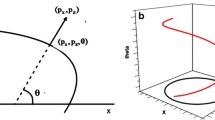Abstract
The motivation for this paper is to provide expressions for first-order partial derivatives of reflection point coordinates, taken with respect to model parameters. Such derivatives are expected to be useful for processes dealing with the problem of estimating velocities for depth migration of seismic data.
The subject of the paper is a particular aspect of ray perturbation theory, where observed parameters—two-way reflection time and horizontal components of slowness, are constraining the ray path when parameters of the reference velocity model are perturbed. The methodology described here is applicable to general rays in a 3D isotropic, heterogeneous medium. Each ray is divided into a shot ray and a receiver ray, i.e., the ray portions between the shot/receiver and the reflection point, respectively. Furthermore, by freezing the initial horizontal slowness of these subrays as the model is perturbed,elementary perturbation quantities may be obtained, comprising derivatives of ray hit positions within theisochrone tangent plane, as well as corresponding time derivatives. The elementary quantities may be estimated numerically, by use of ray perturbation theory, or in some cases, analytically. In particular, when the layer above the reflection point is homogeneous, explicit formulas can be derived. When the elementary quantities are known,reflection point derivatives can be obtained efficiently from a set of linear expressions.
The method is applicable for a common shot, receiver or offset data sorting. For these gather types, reflection point perturbationlaterally with respect to the isochrone is essentially different. However, in theperpendicular direction, a first-order perturbation is shown to beindependent of gather type.
To evaluate the theory, reflection point derivatives were estimated analytically and numerically. I also compared first-order approximations to ‘true’ reflection point curves, obtained by retracing rays for a number of model perturbations. The results are promising, especially with respect to applications in sensitivity analysis for prestack depth migration and in velocity model updating.
Similar content being viewed by others
References
Bishop, T. N., Bube, K. P., Cutler, R. T., Langan, R. T., Love, P. L., Resnick, J. R., Shuey, R. T., Spindler, D. A., andWyld, H. W. (1985),Tomographic Determination of Velocity and Depth in Laterally Varying Media, Geophysics50, 903–923.
Červený, V.,The application of ray tracing to numerical modeling of seismic wavefields in complex structures. InSeismic Shear Waves, Part A: Theory (ed. Dohr, G.) (Geophysical Press, London 1985) pp. 1–24.
Chiu, S. K. L., andStewart, R. R. (1987),Tomographic Determination of Three-dimensional Seismic Velocity Structure Using Well Logs, Vertical Seismic Profiles, and Surface Seismic Data, Geophysics52, 1085–1098.
Coates, R. T., andChapman, C. H. (1990),Ray Perturbation Theory and the Born Approximation, Geophys. J. Internat.100, 379–392.
Farra, V., andMadariaga, R., (1987),Seismic Waveform Modeling In Heterogeneous Media by Ray Perturbation Theory, J. Geophys. Res.92, 2697–2712.
Farra, V., Virieux, J., andMadariaga, R. (1989),Ray Perturbation Theory for Interfaces, Geophys. J. Internat.99, 377–390.
Farra, V., andLe Bégat, S. (1985),Sensitivity of qP-wave Travel Times and Polarization Vectors to Heterogeneity. Anisotropy and Interfaces, Geophys. J. Internat.121, 371–384.
Faye, J. P., andJeannot, J. P. (1986),Prestack Migration Velocities from Focusing Depth Analysis, SEG 56th Annual Meeting, Expanded Abstracts, 438–440.
Gjøystdal, H., andUrsin, B. (1981),Inversion of Reflection Times in Three Dimensions, Geophys.46, 972–983.
Hubral, P., andKrey, T. H.,Interval Velocities from Seismic Reflection Time Measurements (SEG, Tulsa, Oklahoma 1980).
Hubral, P., Schleicher, J., andTygel, M. (1992),Three-dimensional Paraxial Ray Properties, Part I: Basic Relations, J. Seismic Exploration1, 265–279.
Iversen, E., andGjøystdal H. (1994),Event-oriented Velocity Estimation Based on Prestack Data in Time or Depth Domain, EAEG 56th Annual Meeting, Expanded abstracts, Paper no. G016. Accepted for publication in Geophysical Prospecting.
Stork, C. (1992),Reflection Tomography in the Postmigrated Domain, Geophysics57, 680–692.
Ursin, B. (1982),Quadratic Wave Front and Travel-time Approximations in Inhomogeneous Layered Media with Curved Interfaces, Geophysics47, 1012–1021.
van Trier, J. A.,Tomographic Determination of Structural Velocities from Depth-Migrated Seismic Data. (Stanford University, 1990).
Vinje, V., Iversen, E., andGjøystdal, H. (1993a),Travel-time and Amplitude Estimation Using Wave Front Construction, Geophysics58, 1157–1166.
Vinje, V., Iversen, E., Gjøystdal, H., andÅstebøl, K. (1993b),Estimation of Multivalued Arrivals in 3D Models Using Wave Front Construction, EAEG 55th Annual Meeting. Expanded abstracts, Paper no. B019. Accepted for publication in Geophysical Prospecting.
Author information
Authors and Affiliations
Rights and permissions
About this article
Cite this article
Iversen, E. Derivatives of reflection point coordinates with respect to model parameters. PAGEOPH 148, 287–317 (1996). https://doi.org/10.1007/BF00882064
Received:
Revised:
Accepted:
Issue Date:
DOI: https://doi.org/10.1007/BF00882064



